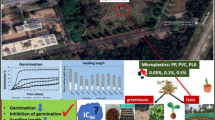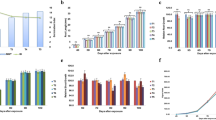Abstract
Nanoplastic pollution has become a significant problem in farmland systems worldwide. However, research on the effects of nanoplastics (NPs) with different charges on field crops is still limited. In our study, NPs with different charges, including unmodified polystyrene nanoplastics (PS), positively charged polystyrene nanoplastics (PS-NH2), and negatively charged polystyrene nanoplastics (PS-SO3H), were investigated for their impacts on seed germination and seedling growth of rape. The results showed that seed water uptake (after 12 h), seed germination, seed vigour, and relative root elongation were all significantly reduced under exposure to NPs (200 mg/L). Similarly, remarkable decreases in plant biomass (root weight, shoot weight), growth (root length, plant height), photosynthesis ability (chlorophyll a, chlorophyll b, carotenoids), essential nutrient uptake (Fe, Mn, Zn, Cu), and plant quality (soluble protein, soluble sugar, crude fibre content) of rape seedlings were also observed after exposure to NPs. Among the three kinds of NPs, PS-NH2 showed stronger effects. Moreover, superoxide dismutase, peroxidase, and catalase activities of rape seedlings were changed, and the content of malondialdehyde was significantly increased under exposure to NPs. Furthermore, positively charged PS-NH2 showed stronger effects on the phenotype, physiology, biochemistry, nutrient uptake, and plant quality of rape. Notably, a comprehensive toxicity evaluation revealed that PS-NH2 had the strongest toxicity to rape. The present study provides important implications for the interaction and risk assessment of NPs and crops in soil-plant systems.

Similar content being viewed by others
References
Bosker T, Bouwman L J, Brun N R, Behrens P, Vijver M G (2019). Microplastics accumulate on pores in seed capsule and delay germination and root growth of the terrestrial vascular plant Lepidium sativum. Chemosphere, 226: 774–781
Cao X, Cui X, Xie M, Zhao R, Xu L, Ni S, Cui Z (2022). Amendments and bioaugmentation enhanced phytoremediation and microecology for PAHs and heavy metals co-contaminated soils. Journal of Hazardous Materials, 426: 128096
Cui X, Geng Y, Li T, Zhao R, Li X, Cui Z (2021). Field application and effect evaluation of different iron tailings soil utilization technologies. Resources, Conservation and Recycling, 173: 105746
Das S, Mukherjee A, Sengupta G, Singh V K (2020). Nano-materials as photocatalysts for pegradation of environmental pollutants. ScienceDirect, 371–401
de Souza Machado A A, Lau C W, Kloas W, Bergmann J, Bachelier J B, Faltin E, Becker R, Görlich A S, Rillig M C (2019). Microplastics can change soil properties and affect plant performance. Environmental Science & Technology, 53(10): 6044–6052
Dong Y, Song Z, Liu Y, Gao M (2021). Polystyrene particles combined with di-butyl phthalate cause significant decrease in photosynthesis and red lettuce quality. Environmental pollution, 278: 116871
Gao J (2006). Experimental Guidance for Plant Physiology. Beijing: Higher Education Press (in Chinese)
Lambert S, Wagner M (2016). Characterisation of nanoplastics during the degradation of polystyrene. Chemosphere, 145: 265–268
Li C, Gao Y, He S, Chi H, Li Z, Zhou X, Yan B (2021a). Quantification of nanoplastic uptake in cucumber plants by pyrolysis gas chromatography/mass spectrometry. Environmental Science & Technology Letters, 8(8): 633–638
Li S, Guo J, Wang T, Gong L, Liu F, Brestic M, Liu S, Song F, Li X (2021c). Melatonin reduces nanoplastic uptake, translocation, and toxicity in wheat. Journal of Pineal Research, 71(3): e12761
Li S, Wang T, Guo J, Dong Y, Wang Z, Gong L, Li X (2021b). Polystyrene microplastics disturb the redox homeostasis, carbohydrate metabolism and phytohormone regulatory network in barley. Journal of Hazardous Materials, 415: 125614
Lian J, Liu W, Meng L, Wu J, Chao L, Zeb A, Sun Y (2021). Foliar-applied polystyrene nanoplastics (PSNPs) reduce the growth and nutritional quality of lettuce (Lactuca sativa L.). Environmental pollution, 280: 116978
Lian J, Wu J, Xiong H, Zeb A, Yang T, Su X, Su L, Liu W (2020). Impact of polystyrene nanoplastics (PSNPs) on seed germination and seedling growth of wheat (Triticum aestivum L.). Journal of Hazardous Materials, 385: 121620
Lian Y, Liu W, Shi R, Zeb A, Wang Q, Li J, Zheng Z, Tang J (2022). Effects of polyethylene and polylactic acid microplastics on plant growth and bacterial community in the soil. Journal of Hazardous Materials, 435: 129057
Liu C, Yang Z, Hu Y (2015). Drought resistance of wheat alien chromosome addition lines evaluated by membership function value based on multiple traits and drought resistance index of grain yield. Field Crops Research, 179: 103–112
Liu J, Yin P, Zhao L (2018). Adverse effect of nano-TiO2 on the marine macroalgae Gracilaria lemaneiformis (Gracilariales, Rhodophyta): growth and antioxidant activity. RSC Advances, 8(51): 29172–29178
Ng E L, Huerta Lwanga E, Eldridge S M, Johnston P, Hu H W, Geissen V, Chen D (2018). An overview of microplastic and nanoplastic pollution in agroecosystems. Science of the Total Environment, 627: 1377–1388
Nizzetto L, Futter M, Langaas S (2016). Are agricultural soils dumps for microplastics of urban origin? Environmental Science & Technology, 50(20): 10777–10779
Ren Z, Gui X, Xu X, Zhao L, Qiu H, Cao X (2021). Microplastics in the soil-groundwater environment: Aging, migration, and co-transport of contaminants: a critical review. Journal of Hazardous Materials, 419: 126455
Rocha R J M, Rodrigues A C M, Campos D, Cícero L H, Costa A P L, Silva D A M, Oliveira M, Soares A M V M, Patrício Silva A L (2020). Do microplastics affect the zoanthid Zoanthus sociatus? Science of the Total Environment, 713: 136659
Saharan V, Kumaraswamy R V, Choudhary R C, Kumari S, Pal A, Raliya R, Biswas P (2016). Cu-chitosan nanoparticle mediated sustainable approach to enhance seedling growth in maize by mobilizing reserved food. Journal of Agricultural and Food Chemistry, 64(31): 6148–6155
Salazar-Cubillas K, Dickhoefer U (2021). Estimating the proportion of in situ rumen-undegraded crude protein from chemical crude protein and fiber fractions in tropical forage grasses and legumes. Animal Feed Science and Technology, 282: 115122
Sun X D, Yuan X Z, Jia Y, Feng L J, Zhu F P, Dong S S, Liu J, Kong X, Tian H, Duan J L, Ding Z, Wang S G, Xing B (2020). Differentially charged nanoplastics demonstrate distinct accumulation in Arabidopsis thaliana. Nature Nanotechnology, 15(9): 755–760
van Weert S, Redondo-Hasselerharm P E, Diepens N J, Koelmans A A (2019). Effects of nanoplastics and microplastics on the growth of sediment-rooted macrophytes. Science of the Total Environment, 654: 1040–1047
Wei X F, Bohlén M, Lindblad C, Hedenqvist M, Hakonen A (2021). Microplastics generated from a biodegradable plastic in freshwater and seawater. Water Research, 198: 117123
Xiang X, Chen Z, Ren D, Xu J, Li X, Ye Z, Chen N, Chen Q, Ma S (2020). Shape engineering of polystyrene particles from spherical to raspberry-like to hollow flower-like via one-step non-surfactant self-templating polymerization of styrene in ethanol-water mixtures. RSC Advances, 10(19): 11535–11542
Yang W, Gao P, Ma G, Huang J, Wu Y, Wan L, Ding H, Zhang W (2021). Transcriptome analysis of the toxic mechanism of nanoplastics on growth, photosynthesis and oxidative stress of microalga Chlorella pyrenoidosa during chronic exposure. Environmental pollution, 284: 117413
Yin L, Wen X, Huang D, Du C, Deng R, Zhou Z, Tao J, Li R, Zhou W, Wang Z, Chen H (2021). Interactions between microplastics/nanoplastics and vascular plants. Environmental pollution, 290: 117999
Yu G, Huang S, Luo X, Zhao W, Zheng Z (2022). Single and combined toxicity effects of nanoplastics and bisphenol F on submerged the macrophyte Hydrilla verticillata. Science of the Total Environment, 814: 152564
Yuan H, Liu Q, Guo Z, Fu J, Sun Y, Gu C, Xing B, Dhankher O P (2021). Sulfur nanoparticles improved plant growth and reduced mercury toxicity via mitigating the oxidative stress in Brassica napus L. Journal of Cleaner Production, 318: 128589
Zadeh L (1965). Fuzzy sets. Information and Control, 8(3): 338–353
Zhang H, Liang J, Luo Y, Tang N, Li X, Zhu Z, Guo J (2022). Comparative effects of polystyrene nanoplastics with different surface charge on seedling establishment of Chinese cabbage (Brassica rapa L.). Chemosphere, 292: 133403
Zhang K, Wang Y, Mao J, Chen B (2020). Effects of biochar nanoparticles on seed germination and seedling growth. Environmental pollution, 256: 113409
Zhu J, Wang J, Zhan X, Li A, White J, Gardea-Torresdey J L, Xing B (2021). Role of charge and size in the translocation and distribution of zinc oxide particles in wheat cells. ACS Sustainable Chemistry & Engineering, 9(34): 11556–11564
Acknowledgements
This work was financially supported by the National Natural Science Foundation of China (Nos. U20A20115 and 42007112) and the Major Technology Innovation Project of Shandong Province (No. 2020CXGC011403). The authors would like to thank all the anonymous referees for their constructive comments and suggestions.
Author information
Authors and Affiliations
Corresponding author
Additional information
Highlights
• Higher concentrations of PS, PS-NH2 and PS-SO3H inhibited seed germination.
• PS, PS-NH2 and PS-SO3H influenced seedling growth in a dose-dependent manner.
• PS, PS-NH2 and PS-SO3H reduced essential nutrients uptake and plant quality.
• PS, PS-NH2 and PS-SO3H increased antioxidant enzyme activities and MDA content.
• Nanoplastic toxicity was related to surface charges.
Supplementary Information for
11783_2023_1643_MOESM1_ESM.pdf
Stress response to nanoplastics with different charges in Brassica napus L. during seed germination and seedling growth stages
Rights and permissions
About this article
Cite this article
Li, T., Cao, X., Zhao, R. et al. Stress response to nanoplastics with different charges in Brassica napus L. during seed germination and seedling growth stages. Front. Environ. Sci. Eng. 17, 43 (2023). https://doi.org/10.1007/s11783-023-1643-y
Received:
Revised:
Accepted:
Published:
DOI: https://doi.org/10.1007/s11783-023-1643-y




